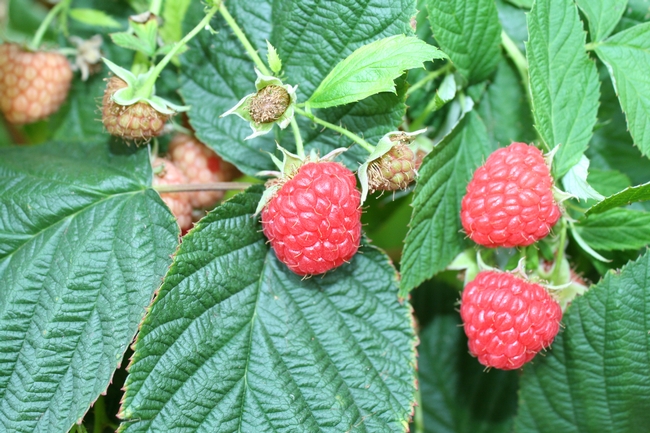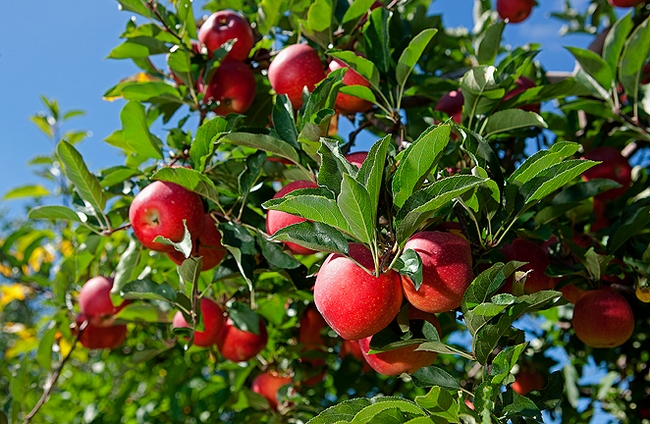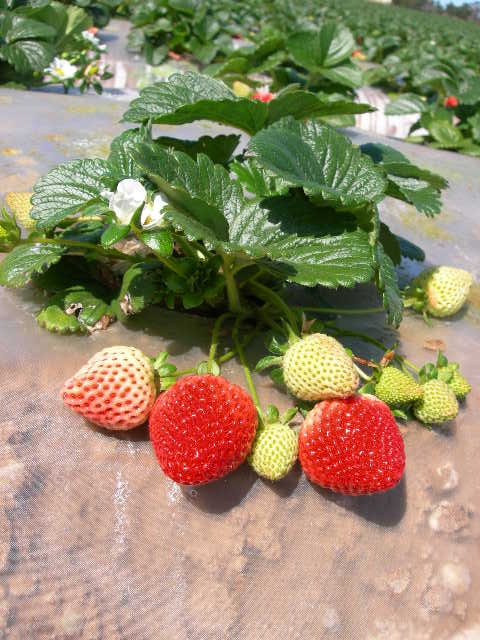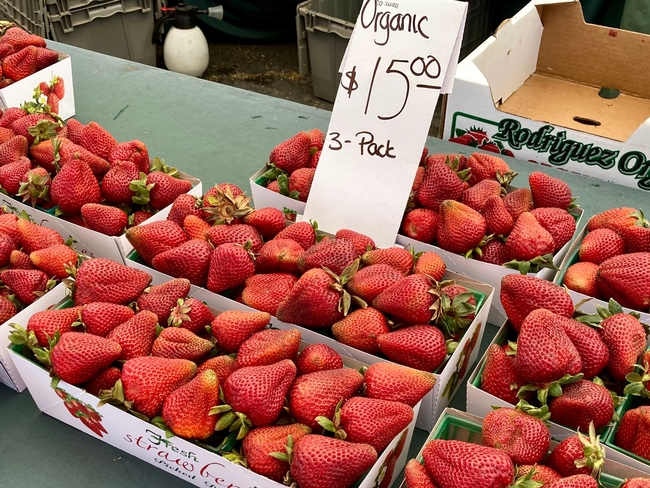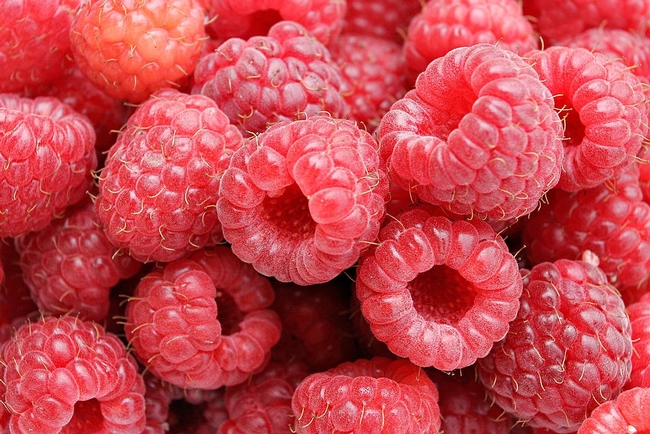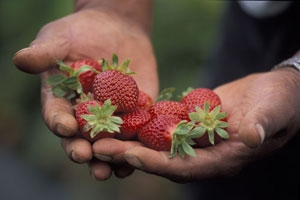Posts Tagged: Mark Bolda
New UC study estimates raspberry production costs on Central Coast
A new study that estimates costs and potential returns for growing raspberries on the Central Coast is available for free from UC Agriculture and Natural Resources, UC Cooperative Extension and the UC Davis Department of Agricultural and Resource Economics.
“These studies provide growers with a baseline to estimate their own costs, which can help when applying for production loans, projecting labor costs, securing market arrangements, or understanding costs associated with water and nutrient management and regulatory programs,” said Brittney Goodrich, UC Cooperative Extension specialist and study co-author.
The UC Cooperative Extension study focuses on raspberries grown in Santa Cruz, Monterey and San Benito counties for the fresh market.
The cost study models a management scenario for a 45-acre farm, 42 acres of which are planted to raspberries. The remaining acres are for the irrigation system, roads and buildings. Each study describes the cultural practices used for establishing, producing and harvesting raspberries, including land preparation, soil fertility and pest management, irrigation and labor needs.
The 36-page study shows costs for each operation, material inputs and costs, and cash and non-cash overhead costs in a variety of formats for three production years. A ranging analysis for each production year is also included and shows potential profits or losses over a range of prices and yields. The authors also note California's 2023 minimum wage and overtime rules.
The new study, “2023 Sample Costs to Produce and Harvest Raspberries,” can be downloaded from the UC Davis Department of Agricultural and Resource Economics website at https://coststudies.ucdavis.edu.
For a detailed explanation of the assumptions and calculations used to estimate the costs and potential returns for each crop, readers can refer to the narrative portion of the study.
For more information, contact Mark Bolda, University of California Cooperative Extension farm advisor, at mpbolda@ucanr.edu, Laura Tourte, emeritus UC Cooperative Extension farm advisor, at ljtourte@ucanr.edu, or Jeremy Murdock in the Department of Agricultural and Resource Economics at jmmurdock@ucdavis.edu.
Sample cost of production studies for many other commodities grown in California are also available for free at https://coststudies.ucdavis.edu.
New UC studies estimate production and harvest costs for coastal apples
Two new studies that can help Central Coast growers and other readers estimate costs and potential returns for both organically and conventionally produced apples for processing were recently released by University of California Agriculture and Natural Resources, UC Cooperative Extension and the UC Davis Department of Agricultural and Resource Economics.
“These studies provide growers with a baseline to estimate their own costs, which can help when applying for production loans, projecting labor costs, securing market arrangements, or understanding costs associated with water and nutrient management and regulatory programs,” said Brittney Goodrich, UC Cooperative Extension specialist and co-author of the studies.
The new studies, “2023 Sample Costs to Produce and Harvest Organic Apples for Processing” and “2023 Sample Costs to Produce and Harvest Apples for Processing,” can be downloaded for free from the UC Davis Department of Agricultural and Resource Economics website at https://coststudies.ucdavis.edu.
The studies focus on processing apples, not fresh market apples, which makes a difference in farming practices. Apples grown for processing on the Central Coast are mostly pressed for juice and sparkling cider.
“Ready-to-eat means that looks matter – blemishes and so forth are a big deal. Juice not so much, it all gets smushed in the end,” said co-author Mark Bolda, UC Cooperative Extension farm advisor for Santa Cruz, Monterey and San Benito counties. “Varieties grown here are Gala, Newtown Pippins, Mitsui and some Granny Smith.”
The cost studies model a management scenario for a 100-acre farm, 20 acres of which are planted to a mature orchard that produces apples for processing. The remaining acres are planted to apples not yet in production, caneberries, strawberries and vegetables. In each study, the authors describe the cultural practices used for organically or conventionally produced apples, including land preparation, soil fertility and pest management, irrigation and labor needs. Harvest costs are also shown.
In six tables, they show the individual costs of each operation for apples, material input costs, and cash and non-cash overhead costs in a variety of formats. A ranging analysis shows potential profits over a range of prices and yields.
For a detailed explanation of the assumptions and calculations used to estimate the costs and potential returns for each crop, readers can refer to the narrative portion of each study.
For more information, contact Mark Bolda at mpbolda@ucanr.edu; Laura Tourte, emeritus UCCE advisor, at ljtourte@ucanr.edu; or Jeremy Murdock of UC Davis Department of Agricultural and Resource Economics at jmmurdock@ucdavis.edu.
Sample cost of production studies for many other commodities grown in California are also available for free at https://coststudies.ucdavis.edu
UC study breaks down costs of growing organic strawberries
Thinking about commercially growing organic strawberries on the Central Coast?
To help prospective and current growers evaluate financial feasibility, the University of California has estimated costs to produce and harvest organic strawberries for fresh market in Santa Cruz, San Benito and Monterey counties.
“This revise of the last cost-of-production study incorporates the newest in labor costs along with updates on cultural techniques,” said study co-author Mark Bolda, UC Cooperative Extension strawberries and caneberries advisor in Santa Cruz, San Benito and Monterey counties.
The new study, “Sample Costs to Produce and Harvest Organic Strawberries in the Central Coast Region-2022,” has been released by UC Agriculture and Natural Resources and UC Davis Department of Agricultural and Resource Economics.
The analysis is based on a hypothetical well-managed organic strawberry farm using practices common to the region, but the costs, materials and practices shown in this study will not apply to all farms. Growers, UC Cooperative Extension farm advisors and specialists, pest control advisers and others provided input and reviewed the methods and findings of the study.
“Current growers can use it as a baseline to compare with their own cost and returns estimates to make sure they have an accurate picture of the profitability of their organic strawberry enterprise,” said co-author Brittney Goodrich, UC Cooperative Extension agricultural economics specialist. “Many agricultural lenders use these studies as a baseline to determine whether to approve operating or investment loan requests from current and potential strawberry growers.”
The researchers assume a farm operation size of 30 contiguous acres of rented land, with strawberries are planted on 27 acres. The study includes a list of suitable strawberry varieties for the region, but no specific variety is used in the study. The crop is harvested by hand and packed into trays containing eight 1-pound clamshells from April through early October, with peak harvest in June through August.
The authors describe the assumptions used to identify current costs for production material inputs and cash and non-cash overhead. Ranging analysis tables show net profits over a range of prices and yields. Other tables show the monthly cash costs, the costs and returns per acre, hourly equipment costs, and the whole farm annual equipment, investment and business overhead costs.
The study's expanded section on labor includes information on California's new minimum wage and overtime laws.
“It's reached a wider audience this time through presentations of the material to students at Cal Poly [San Luis Obispo] and also a group of USDA officials at the California Strawberry Commission,” said Bolda.
“All of this just underlines the value of these studies to California growers and others working in agriculture,” Bolda said.
Free copies of this study and other sample cost of production studies for many commodities are available. To download the cost studies, visit the UC Davis Department of Agricultural and Resource Economics website at https://coststudies.ucdavis.edu.
This cost and returns study was funded by the UC Davis Department of Agricultural and Resource Economics.
For additional information or an explanation of the calculations used in the studies, contact Jeremy Murdock, UC Davis Department of Agricultural and Resource Economics, at jmmurdock@ucdavis.edu or UC Cooperative Extension's Bolda at (831) 763-8025.
Growers get help from UC in estimating raspberry production costs
When growers are considering a new crop to plant, and penciling out their expenses and income, cost estimates from the University of California may help. A new cost and return study for commercially producing raspberries released by UC ANR Agricultural Issues Center and UC Cooperative Extension includes an expanded section on labor.
Sample costs to establish, produce and harvest raspberries for fresh market in Santa Cruz, Monterey and San Benito counties are presented in “Sample Costs to Produce and Harvest Fresh Market Raspberries in the Central Coast Region – 2017.”
“The study focuses on the many complexities and costs of primocane raspberry production over a three-year period, including crop establishment, fertility practices, overhead tunnel management, harvest and rising labor costs," said Mark Bolda, UC Cooperative Extension farm advisor and co-author of the study.
The analysis is based upon a hypothetical well-managed farming operation using practices common to the region. The costs, materials, and practices shown in this study will not apply to all farms. Growers, UC Cooperative Extension farm advisors and other agricultural associates provided input and reviewed the methods and findings of the study.
“This raspberry cost and return study is the result of significant effort on the part of UC Cooperative Extension, the Agricultural Issues Center and several grower and industry collaborators, who shared their expertise and contributed mightily to the end product,” said Laura Tourte, UC Cooperative Extension farm management advisor and co-author of the study.
This study assumes a farm size of 45 contiguous acres of rented land. Raspberries are planted on 42 acres. The crop is hand-harvested and packed into 4.5-pound trays. There is a fall harvest during production year 1, a spring and fall harvest during production year 2, and a spring harvest during production year 3. Each harvest is three months long.
The authors describe the assumptions used to identify current costs for production material prices and yields. Tables show the phase-in schedules for California's minimum wage and overtime laws through the year 2022. Other tables show the monthly cash costs, the costs and returns per acre, hourly equipment costs, and the whole farm annual equipment, investment and business overhead costs.
Free copies of “Sample Costs to Produce and Harvest Fresh Market Raspberries in the Central Coast Region - 2017” can be downloaded from the UC Davis Department of Agricultural and Resource Economics website https://coststudies.ucdavis.edu. Sample cost of production studies for many other commodities are also available at the website.
The cost and returns studies program is funded by the UC Agricultural Issues Center and UC Cooperative Extension, both of which are part of the UC Division of Agriculture and Natural Resources, and the UC Davis Department of Agricultural and Resource Economics.
For additional information or an explanation of the calculations used in the studies, contact the UC Agricultural Issues Center at (530) 752-4651 or UC Cooperative Extension advisors Mark Bolda at (831) 763-8025 or Laura Tourte at (831) 763-8005 in Santa Cruz County.
Organic strawberries may be more nutritious and longer lasting
While numerous studies have shown that organically grown foods contain fewer pesticide residues, there has been little convincing scientific evidence that organic crops taste better or are more nutritious.
Now a two-year evaluation of California strawberries has found that organic strawberries, while lower in phosphorus and potassium, had significantly higher “antioxidant activity and concentrations of ascorbic acid [vitamin C] and phenolic compounds, longer shelf life, greater dry matter, and for ‘Diamante’, better taste and appearance” than conventionally grown berries.
The study has been getting a lot of media attention, including coverage in the L.A. Times, Seattle Times and National Public Radio.
Published in the September 2010 issue of PLoS ONE, an open-access, peer-reviewed journal, the study looked at 13 pairs of commercial organic and conventional strawberry agroecosystems. The fields were all in the Watsonville area, where 40 percent of California strawberries are produced. All of the paired farms had been in production at least five years and had comparable soil types. The researchers collected multiple samples in 2004 and 2005, and evaluated the strawberries for minerals, shelf life and phytochemicals. A sensory panel compared the organoleptic properties of three different varieties of fruit.
Regarding post-harvest durability, the organic berries — despite no fungicide applications — had significantly less gray mold and significantly less loss of fresh weight two days after harvest than conventional berries.
“These results indicated that the organic strawberries have a longer shelf life than conventional strawberries because of slower rotting and dehydration, perhaps due to augmentation of cuticle and epidermal cell walls,” the authors wrote.
Mark Bolda, UC Cooperative Extension farm advisor for strawberries in Santa Cruz County, said there are a number of variables that could account for a reduction in gray mold infestation.
“For example, organic plants are smaller in size, have a smaller canopy and consequently are drier because of more air circulation,” Bolda said. “Flowers and fruit subsequently present a drier and less appealing host for this fungus.”
Not surprisingly, the study found that “soils on the organic farms had significantly more carbon and nitrogen, greater microbial biomass and function, and great functional gene abundance and diversity.” The authors attributed this to the fact that the conventional sites were fumigated with methyl bromide and treated with synthetic pesticides, while the organic sites were not and received double the amounts of compost.
The researchers were affiliated with Washington State University, Pullman; Utah State University, Logan; Oak Ridge National Laboratory, Oak Ridge, Tennessee; and University of Oklahoma, Norman.
U.S. consumers continue to clamor for organic foods, sales of which have increased nearly six-fold since 1997 to $21.8 billion in 2008 (3 percent of total U.S. food sales). California produces 87 percent of the nation’s strawberries, of which nearly 5 percent are organically grown.


